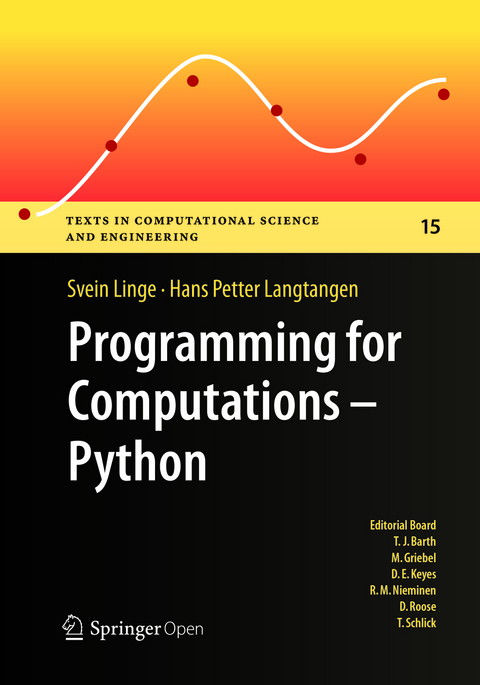
Programming for Computations - Python
Springer International Publishing (Verlag)
978-3-319-81282-3 (ISBN)
This book presents computer programming as a key method for solving mathematical problems. There are two versions of the book, one for MATLAB and one for Python. The book was inspired by the Springer book TCSE 6: A Primer on Scientific Programming with Python (by Langtangen), but the style is more accessible and concise, in keeping with the needs of engineering students.
The book outlines the shortest possible path from no previous experience with programming to a set of skills that allows the students to write simple programs for solving common mathematical problems with numerical methods in engineering and science courses. The emphasis is on generic algorithms, clean design of programs, use of functions, and automatic tests for verification.
Svein Linge is a professor of modelling and simulation at the University College of Southeast Norway and holds a Dr. Scient. degree in biomechanics from the Norwegian School of Sport Sciences. He works part-time at a Norwegian Center of Excellence: "Center for Biomedical Computing", at Simula Research Laboratory, to which he has been linked for the last 13 years. His main research interests includes cerebrospinal fluid dynamics, cardiac electro-mechanics and sport biomechanics. Over the last decade, Linge has been particularly engaged in reforming the engineering education in mathematics and physics to take advantage of computer programming and simulation.
Preface.- The first few steps.- Basic constructions.- Computing integrals.- Solving ordinary differential equations.- Solving partial differential equations.- Solving nonlinear algebraic equations.- Getting access to Python.- References.- Index
"The book uses programming to impart a deeper understanding of the pragmatic meaning of some of the mathematics most frequently used in engineering and the sciences. ... This very good introductory textbook could be used in a variety of courses. A motivated reader with knowledge of calculus could easily use it for self-study. I highly recommend it." (David Naugler, Computing Reviews, February, 2017)
"This book is intended for novice programmers, especially students, teachers, engineers and scientists from areas related to mathematics and numerical mathematics. ... each treated concept is illustrated and explained in detail by means of working examples. On the basis of exercises, the reader is given the opportunity to deepen acquired knowledge. ... The clear presentation and the large number of concrete examples, often with a graphical output, make this book ideally suited for self-study and ensures a quick success." (Stefan Meyer, zbMATH 1350.68003, 2017)| Erscheinungsdatum | 05.03.2022 |
|---|---|
| Reihe/Serie | Texts in Computational Science and Engineering |
| Zusatzinfo | XVI, 232 p. 45 illus. |
| Verlagsort | Cham |
| Sprache | englisch |
| Maße | 178 x 254 mm |
| Gewicht | 478 g |
| Themenwelt | Mathematik / Informatik ► Informatik |
| Mathematik / Informatik ► Mathematik ► Analysis | |
| Mathematik / Informatik ► Mathematik ► Angewandte Mathematik | |
| Mathematik / Informatik ► Mathematik ► Computerprogramme / Computeralgebra | |
| Schlagworte | Differential Equations • Numerical Methods • programming • Python • verification |
| ISBN-10 | 3-319-81282-3 / 3319812823 |
| ISBN-13 | 978-3-319-81282-3 / 9783319812823 |
| Zustand | Neuware |
| Informationen gemäß Produktsicherheitsverordnung (GPSR) | |
| Haben Sie eine Frage zum Produkt? |
aus dem Bereich


